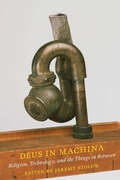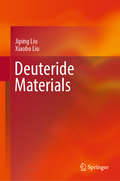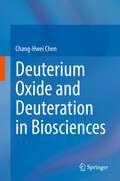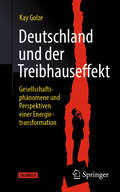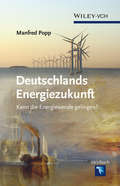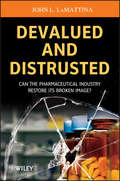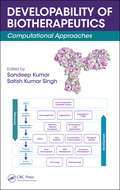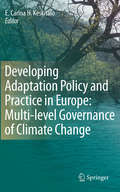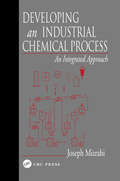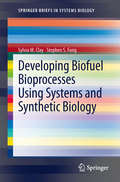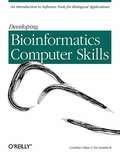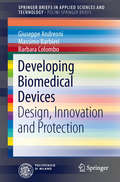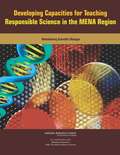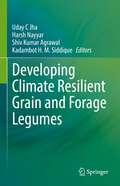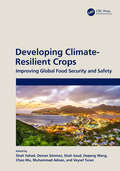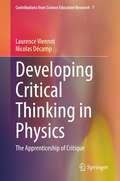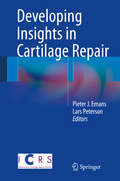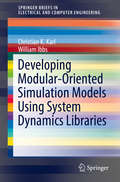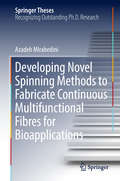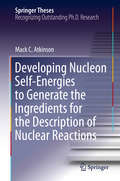- Table View
- List View
Deus Est Caritas: The Voice of Gabriele Biondo on Personal Justification and Church Reform (International Archives of the History of Ideas Archives internationales d'histoire des idées #245)
by Vito GuidaThe book examines the life and the writings of Gabriele Biondo, a secular priest who lived in the little town of Modigliana between the second half of the fifteenth century and the first decades of the sixteenth century. Through a careful examination of his writings and the sources he used, this book allows the reader to obtain a more precise understanding of Biondo, his background, his life, his movements, the difficulties that he encountered (mainly with the ecclesiastical authorities and the other members of the clergy, but also with civic leaders), and the main events of his life. Additionally, Biondo was the leader of a minor following formed by nuns, secular women, and laymen. Therefore, this book illustrates Biondo’s pastoral activity, the ideas and principles that supported his actions, and the objectives he was pursuing. Given these various objectives, this book is of interest to those scholars and academics interested in the religious tensions that swept through Europe in the years immediately preceding the Protestant Reformation and who, consequently, seek to investigate Biondo’s personal and complex answer to these tensions.
Deus in Machina: Religion, Technology, and the Things in Between
by Jeremy StolowThe essays in this volume explore how two domains of human experience and action—religion and technology—are implicated in each other. Contrary to commonsense understandings of both religion (as an “otherworldly” orientation) and technology (as the name for tools, techniques, and expert knowledges oriented to “this” world), the contributors to this volume challenge the grounds on which this division has been erected in the first place.What sorts of things come to light when one allows religion and technology to mingle freely? In an effort to answer that question, Deus in Machina embarks upon an interdisciplinary voyage across diverse traditions and contexts where religion and technology meet: from the design of clocks in medieval Christian Europe, to the healing power of prayer in premodern Buddhist Japan, to 19th-century Spiritualist devices for communicating with the dead, to Islamic debates about kidney dialysis in contemporary Egypt, to the work of disability activists using documentary film to reimagine Jewish kinship, to the representation of Haitian Vodou on the Internet, among other case studies.Combining rich historical and ethnographic detail with extended theoretical reflection, Deus in Machina outlines new directions for the study of religion and/as technology that will resonate across the human sciences, including religious studies, science and technology studies, communication studies, history, anthropology, and philosophy.
Deuteride Materials
by Jiping Liu Xiaobo LiuThis is the very first book that offers an up-to-date and comprehensive overview on deuteride. It not only includes the concept, existing forms, key characteristics, but also reviews the preparation and characterization technologies and the latest research developments of deuteride. The special properties such as the nuclear properties, isotropic and neutron effect, poisonousness, radioactivity, volume expansion are systematically discussed to build up the sound understanding of the materials. In particular, this work reviews a number of commercial and scientific uses of the materials including nuclear reactors, NMR spectroscopy and medicines. Researchers and industrial professionals in medicine, chemistry, biochemistry, environmental sciences and defense sciences will benefit from this work.
Deuterium Oxide and Deuteration in Biosciences
by Chang-Hwei ChenThis new book provides comprehensive coverage of the subjects of deuterium oxide and deuteration in biosciences, with an emphasis on the biochemical, biomedical, and pharmacological aspects. Deuterium oxide and deuteration effects also offer various implications for health-related issues, including diseases, vaccines and drugs. Organized in six sections, the chapter topics include the role of regular and heavy water in biosciences, and their implications to biomolecules, biochemical processes, health-related research, and pharmacology. Due to the broad scope, the book may be used as a supplemental text for upper-level undergraduate and graduate courses in the related fields of biochemistry, biology, biomedical sciences, biophysics, and pharmacology. Researchers and pharmaceutical industry professionals will also find the content useful in order to gain knowledge and better understand the implications of deuterium oxide and deuteration research.
Deutsch-jüdische Begegnungen mit dem Buddhismus: Zwischen Moses und Buddha, 1890-1940
by Sebastian MuschIn Deutschland verwandelte sich der Buddhismus um die Jahrhundertwende von einem obskuren Thema, das nur für einige wenige Gelehrte von Interesse war, in ein kulturelles Phänomen. Viele der bedeutendsten Autoren dieser Zeit wurden von diesem rasanten Aufstieg des Buddhismus tiefgreifend beeinflusst - unter ihnen einige der bekanntesten Namen des deutsch-jüdischen Kanons. Sebastian Musch gräbt diese vernachlässigte Dimension deutsch-jüdischer Identität aus und zeichnet anhand von philosophischen Abhandlungen, Romanen, Essays, Tagebüchern und Briefen die Geschichte der jüdisch-buddhistischen Begegnungen bis zum Beginn des Zweiten Weltkriegs nach. Franz Rosenzweig, Martin Buber, Leo Baeck, Theodor Lessing, Jakob Wassermann, Walter Hasenclever und Lion Feuchtwanger werden neben anderen, weniger bekannten Persönlichkeiten wie Paul Cohen-Portheim und Walter Tausk vorgestellt. Wie Musch zeigt, verhandelten diese Denker, als sie über den Buddhismus schrieben, auch ihr eigenes Jüdischsein.
Deutschland und der Treibhauseffekt: Gesellschaftsphänomene und Perspektiven einer Energietransformation
by Kay GolzeHier wird ein Ansatz zur Beschreibung des gesellschaftlichen Phänomens Klimawandel präsentiert. Die Suche nach den Ursachen und Auswirkungen dieses epochalen und globalen Naturereignisses erfolgt außerhalb der Klimawissenschaften, aber unter deren Berücksichtigung. Die Analysen geben einen unerwartet umfassenden Blick in die innere Mechanik des Phänomens und öffnen neue Fenster zur Betrachtung. Auf dieser Basis wird das einmalige deutsche Gesellschaftsexperiment der Energietransformation durchleuchtet.
Deutschlands Energiezukunft: Kann die Energiewende gelingen?
by Manfred PoppDeutschlands Energiezukunft Kann die Energiewende gelingen? Deutschlands Energiezukunft – wie wird sie aussehen? Mit der Energiewende hat sich Deutschland das neue und ehrgeizige Ziel gesetzt, bis zum Jahr 2050 eine klimaneutrale Energieversorgung zu verwirklichen. Kann das gelingen? Dieses Buch widmet sich der Entwicklung und den Möglichkeiten zur Deckung des Energiebedarfs der Welt sowie den Alternativen, die Deutschland zur Verfügung stehen. Der Autor verzichtet auf eine Polarisierung des Themas und gibt keine fertige Antwort auf die Frage nach Deutschlands Energiezukunft. Er will vielmehr den Leser in die Lage versetzen, sich ein eigenes Urteil bilden zu können über die Größe der Herausforderung, die Probleme, mit denen wir konfrontiert sind, und die Lösungswege, die uns offenstehen. Ergänzendes Material unter www.wiley-vch.de.
Devalued and Distrusted
by John L. LamattinaAn expert's view on solving the challenges confronting today's pharmaceutical industryAuthor John LaMattina, a thirty-year veteran of the pharmaceutical industry and former president of Pfizer's Global R&D Division, is internationally recognized as an expert on the pharmaceutical industry. His first book, Drug Truths: Dispelling the Myths About Pharma R&D, was critically acclaimed for clearing up misconceptions about the pharmaceutical industry and providing an honest account of the contributions of pharmaceutical research and development to human health and well-being.As he toured the country discussing Drug Truths, Dr. LaMattina regularly came across people who were filled with anger, accusing the pharmaceutical industry of making up diseases, hiding dangerous side effects, and more. This book was written in response to that experience, critically examining public perceptions and industry realities.Starting with "4 Secrets that Drug Companies Don't Want You to Know," Devalued and Distrusted provides a fact-based account of how the pharmaceutical industry works and the challenges it faces. It addresses such critical issues as:Why pharmaceutical R&D productivity has declinedWhere pharmaceutical companies need to invest their resourcesWhat can be done to solve core health challenges, including cancer, diabetes, and neurodegenerative diseasesHow the pharmaceutical industry can regain public trust and resuscitate its imageOur understanding of human health and disease grows daily; however, converting science into medicine is increasingly challenging. Reading Devalued and Distrusted, you'll not only gain a greater appreciation of those challenges, but also the role that the pharmaceutical industry currently plays and can play in solving those challenges.Get to know the author: Read an interview with John LaMattina or watch a video on ChemistryViews! Interview: John LaMattina: 30 Years in PharmaVideo: Can the Pharmaceutical Industry Restory its Broken Image?
Developability of Biotherapeutics: Computational Approaches
by Sandeep Kumar Satish Kumar SinghBiopharmaceuticals are emerging as frontline medicines to combat several life-threatening and chronic diseases. However, such medicines are expensive to develop and produce on a commercial scale, contributing to rising healthcare costs. Developability of Biotherapeutics: Computational Approaches describes applications of computational and molecular
Developing Adaptation Policy and Practice in Europe: Multi-level Governance of Climate Change
by E. Carina KeskitaloMitigation will not be sufficient for us to avoid climate change and we will need to adapt to its consequences. This book targets the development of adaptation policy in European countries with different relations between central and regional/local government.
Developing An Industrial Chemical Process: An Integrated Approach
by Joseph MizrahiThe development and implementation of a new chemical process involves much more than chemistry, materials, and equipment. It is a very complex endeavor and its success depends on the effective interactions and organization of professionals in many different positions - scientists, chemical engineers, managers, attorneys, economists, and specialists
Developing Biofuel Bioprocesses Using Systems and Synthetic Biology
by Sylvia M. Clay Stephen S. FongAdvances in technological and analytical methods have fostered rapid growth of systems biology and synthetic biology. There continues to be rapid changes and discoveries in both fields with a small number of recent peer-reviewed reviews indicating some of the relationships between systems biology and synthetic biology. This proposed SpringerBrief will cover core concepts of systems biology and synthetic biology and illustrate the implementation of associated research methodologies for an integrated approach to specifically address engineering microorganisms for biofuel production.
Developing Bioinformatics Computer Skills
by Per Jambeck Cynthia GibasIntroduces the field of bioinformatics: "the application of computational and analytical methods to biological problems.
Developing Bioinformatics Computer Skills
by Per Jambeck Cynthia GibasBioinformatics--the application of computational and analytical methods to biological problems--is a rapidly evolving scientific discipline. Genome sequencing projects are producing vast amounts of biological data for many different organisms, and, increasingly, storing these data in public databases. Such biological databases are growing exponentially, along with the biological literature. It's impossible for even the most zealous researcher to stay on top of necessary information in the field without the aid of computer-based tools. Bioinformatics is all about building these tools. Developing Bioinformatics Computer Skills is for scientists and students who are learning computational approaches to biology for the first time, as well as for experienced biology researchers who are just starting to use computers to handle their data. The book covers the Unix file system, building tools and databases for bioinformatics, computational approaches to biological problems, an introduction to Perl for bioinformatics, data mining, and data visualization. Written in a clear, engaging style, Developing Bioinformatics Computer Skills will help biologists develop a structured approach to biological data as well as the tools they'll need to analyze the data.
Developing Biomedical Devices
by Giuseppe Andreoni Massimo Barbieri Barbara ColomboDuring the past two decades incredible progress has been achieved in the instruments and devices used in the biomedical field. This progress stems from continuous scientific research that has taken advantage of many findings and advances in technology made available by universities and industry. Innovation is the key word and in this context legal protection and intellectual property rights (IPR) are of crucial importance. This book provides students and practitioners with the fundamentals for designing biomedical devices and explains basic design principles. Furthermore, as an aid to the development of devices and products for healthcare, it presents a brief description of the human body, covering anatomy and physiology, that will assist the reader in understanding the origin of biosignals, their significance and the technology to be used in their measurement. Issues concerning IPR and protections are also fully discussed, with examples and opportunities for IPR exploitation.
Developing Capacities for Teaching Responsible Science in the MENA Region
by National Research Council Division on Earth and Life Studies Committee on Developing a Framework for an International Faculty Development Project on Education About Research in the Life Sciences with Dual Use Potential Board on Life Science The World Academy of SciencesSpurred on by new discoveries and rapid technological advances, the capacity for life science research is expanding across the globe--and with it comes concerns about the unintended impacts of research on the physical and biological environment, human well-being, or the deliberate misuse of knowledge, tools, and techniques to cause harm. This report describes efforts to address dual use issues by developing institutes around the world that will help life sciences faculty learn to teach about the responsible conduct of science. Based on the successful National Academies Summer Institute for Undergraduate Biology Education and on previous NRC reports on effective methods for teaching about dual use issues, the report's authoring committee designed a general framework for the faculty institutes and chose the Middle East-North Africa (MENA) region to test a prototype faculty institute. In September 2012, the first Institute was held in Aqaba, Jordan, bringing together 28 participants from Algeria, Egypt, Jordan, Libya, and Yemen to engage with effective, evidence-based teaching methods, develop curricular materials for use in their own classrooms, and become community leaders on dual use and related topics. Developing Capacities for Teaching Responsible Science in the MENA Region: Refashioning Scientific Dialogue offers insights from the institute that will help in the design and implementation of future programs in the MENA region, and in other parts of the world.
Developing Climate Resilient Grain and Forage Legumes
by Harsh Nayyar Kadambot H. M. Siddique Uday C Jha Shiv Kumar AgrawalThis edited book covers all aspects of grain legumes including negative impact of abiotic and biotic stresses under the changing global climate. It discusses the role of various subject disciplines ranging from plant breeding, genetics, plant physiology, molecular biology, and genomics to high-throughput phenotyping and other emerging technologies for sustaining global grain and fodder legume production to alleviate impending global food crises. The book offers strategies to ensure plant-based dietary protein security across the globe. It covers all major commercial legume crops used as food, feed and fodder. This book is targeted to graduate and postgraduate students, researchers, progressive farmers and policymakers to inform them of the importance of cultivating grain and fodder legumes for future global food and nutritional security and for maintaining sustainable ecosystem.
Developing Climate-Resilient Crops: Improving Global Food Security and Safety (Footprints of Climate Variability on Plant Diversity)
by Shah FahadDeveloping Climate-Resilient Crops: Improving Global Food Security and Safety is timely, as the world is gradually waking up to the fact that a global food crisis of enormous proportions is brewing. Climate change is creating immense problems for agricultural productivity worldwide, resulting in higher food prices. This book elucidates the causative aspects of climate modification related to agriculture, soil, and plants, and discusses the relevant resulting mitigation process and also how new tools and resources can be used to develop climate-resilient crops. Features: Addresses the limits of the anthropogenic global warming theory advocated by the Intergovernmental Panel on Climate Change Presents the main characters (drought tolerance, heat tolerance, water-use efficiency, disease resistance, nitrogen-use efficiency, nitrogen fixation, and carbon sequestration) necessary for climate-resilient agriculture Delivers both theoretical and practical aspects, and serves as baseline information for future research Provides valuable resource for those students engaged in the field of environmental sciences, soil sciences, agricultural microbiology, plant pathology, and agronomy Highlights factors that are threatening future food production
Developing Critical Thinking in Physics: The Apprenticeship of Critique (Contributions from Science Education Research #7)
by Laurence Viennot Nicolas DécampThis book promotes the effective implementation and development of critical analysis in physics. It focuses on explanatory texts concerning subjects typically dealt with in secondary or higher education and addressed in an academic or popular context. It highlights the general difficulties and obstacles inherent in teaching physics and shows how some tools can help to combine successful criticism and better understanding. The book examines the main reasons to call a text into question and looks at risk factors such as simplifications, story-like explanations and visual analogies. It takes inventory of the benefits and limits of critical analysis and discusses the complex links between conceptual mastery and critical attitude. The book ends by offering tools to activate critical thinking and ways for educators to guide students towards productive critical analysis.
Developing Insights in Cartilage Repair
by Pieter J. Emans Lars PetersonThis comprehensive book discusses cartilage repair and all its aspects. These aspects vary from basic insights in cartilage biology and regeneration via MRI, to results of existing cartilage repair techniques and upcoming novel approaches. Fundamental cartilage biology is the topic covered within the first chapters of the book. These chapters not only provide an insight in healthy, damaged and regenerative cartilage but also describe developments in gene therapy and methods to enhance chondrogenesis of stemcells and prevent hypertophic differentiation. There is a huge progress in the possibilities of MR imaging of both healthy, damaged and regenerative cartilage. These developments not only enable better monitoring of cartilage repair but may also unravel the pathophysiology of the development of cartilage defects. Different cartilage repair techniques (e. g. allografts, autologous chondrocytes transplantation [ACT], microfracture), there technical aspects (e. g. developments towards an total arthroscopic approach), pitfalls, and outcomes are reported in the following chapters. In these chapters factors important for the results of cartilage repair such as meniscal repair, patient factors are described. Finally, an overview of novel cartilage repair techniques such as minced cartilage, denovo cartilage and more areas are discussed in this comprehensive addition to the literature.
Developing Modular-Oriented Simulation Models Using System Dynamics Libraries
by Christian K. Karl William IbbsThis SpringerBrief introduces the development and practical application of a module-oriented development framework for domain specific system-dynamic libraries (SDL approach), which can be used in the simulation of multi-causal and dynamic relationships on different levels of an industry, as an example the construction industry. Multidisciplinary research and development teams, scientists from different domains as well as practitioners can develop SDL units from varying perspectives based on this approach. For example, the explanation of the risk situation of a company, the identification and evaluation of project risks, endangered operational procedures on various functional levels, or to improve the understanding of the decision making process in detail. This book is an excellent source for researchers, programmers and practitioners. It enables the development of suitable simulation systems from the beginning and demonstrates that it is possible to connect the development of simulation models and daily work. It provides advanced-level students from different domains with a comprehensive overview and clear understanding of a new and valuable modeling technique.
Developing Novel Spinning Methods to Fabricate Continuous Multifunctional Fibres for Bioapplications (Springer Theses)
by Azadeh MirabediniThis book describes the development of three dimensional electroactive fibres using a novel coaxial wet-spinning approach from organic conductors in combination with non-conducting hydrogel polymers. This book also presents the characterization and evaluation of multiaxial biofibres in terms of mechanical, physical, electrochemical and biological properties, and explores their use in a diverse range of applications including implantable electrodes, drug delivery systems and energy-storage systems.In the first chapter, the author highlights the significance of engineering three dimensional fibres, introduces the involved hydrogels and organic conductors with emphasis on their biomedical application, and collects some of the previously established methods for fabrication of biofibres. In the second chapter, particular attention is given to the overall experimental fabrication methods and characterization analyses conducted in the work. Chapters three to five present the main findings of this work, in which readers will discover how novel hybrid hydrogel fibres with an inner core of chitosan and alginate were prepared and characterized, how graphene was incorporated into coaxial wet-spun biofibres, and how one-dimensional triaxial fibres were developed using a novel coaxial wet-spinning fibre production method and applied as potential battery devices. In the final chapter of this work, the author summarizes the main achievements of the work and outlines some recommendations for future research.
Developing Nucleon Self-Energies to Generate the Ingredients for the Description of Nuclear Reactions (Springer Theses)
by Mack C. AtkinsonThis thesis develops the dispersive optical model into a tool that allows for the assessment of the validity of nuclear reaction models, thereby generating unambiguous removal probabilities of nucleons from valence orbits using the electron-induced proton knockout reaction. These removal probabilities document the substantial quantitative degree in which nuclei deviate from the independent-particle model description. Another outcome reported within is the prediction for the neutron distribution of Ca-40, Ca-48, and Pb-208. The neutron radii of these nuclei have direct relevance for the understanding of neutron stars and are currently the subject of delicate experiments. Unlike other approaches, the current method is consistent with all other relevant data and describes nuclei beyond the independent-particle model. Finally, a new interpretation of the saturation probabilities of infinite nuclear matter is proposed suggesting that the semi-empirical mass formula must be supplemented with a better extrapolation from nuclei to infinite matter.
Developing Reflective Judgment
by Patricia M. King Karen Strohm KitchenerHow do students learn to reason and think about complex issues? This book fills a critical gap in our understanding of along-neglected facet of the critical thinking process: reflective judgment. Drawing on extensive cross-sectional and longitudinal research, King and Kitchener detail the series of stages that lay the foundation for reflective thinking, and they trace the development of reflective judgment through adolescence and adulthood. The authors also describe the implications of the Reflective Judgment Model for working with students in the classroom and beyond--encouraging educators to think differently about interactions with their students and to create ways of more effectively promoting the ability to make reflective judgments.

